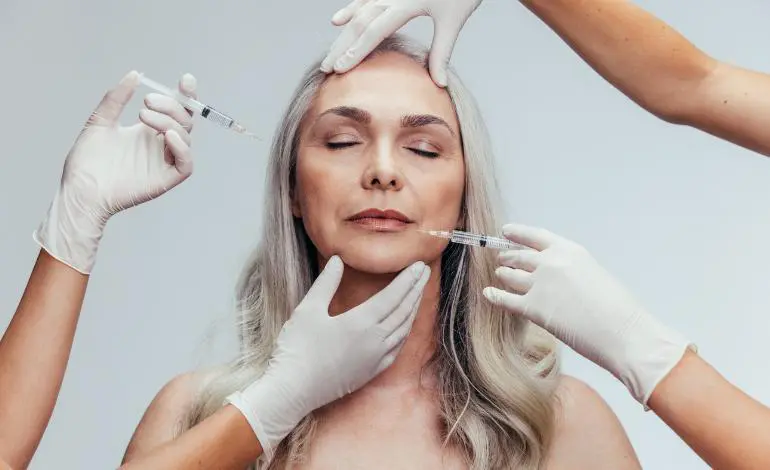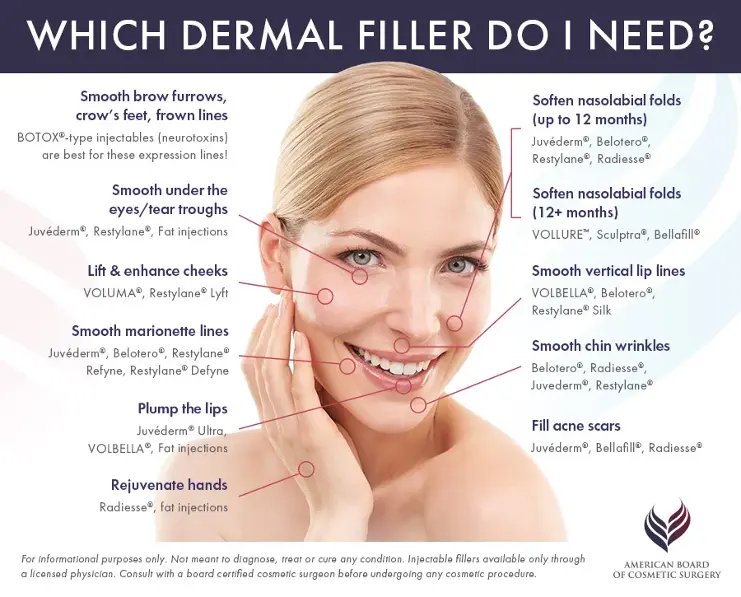Medical Aesthetics
Wellness & Aesthetics Categories

Botox
Botox injections are known primarily for the ability to reduce the appearance of facial wrinkles. They’re also used to treat conditions such as neck spasms (cervical dystonia), excessive sweating (hyperhidrosis), an overactive bladder and lazy eye. Botox injections may also help prevent chronic migraines. Botox injections use a toxin called onobotulinumtoxinA to temporarily prevent a muscle from moving.
Benefits of Botox
One of the most significant benefits of getting Botox treatment is that it is an easy way to enhance your natural beauty. Botox is used as an anti-aging treatment, as it is an easy way to lessen the appearance of wrinkles. This means that Botox injections can improve anything from severe forehead lines to frown lines and all parts in between. Because these areas are what people notice first when they meet you, getting Botox is an easy way to improve your appearance and make a better first impression.
Finally, Botox® also has applications in the lower face, including the chin, jaw, and neck.
-
Chin: Getting
Botox® in the chin
Is a common solution for chin dimpling, a condition that occurs when the muscles in the lower face become overactive, resulting in a puckered appearance. -
Jaw: On the flip side,
Jaw Botox®
Treatments target the masseter muscle and help reduce the appearance of a clenched jaw, thus slimming the face. -
Neck: Finally,
Neck Botox®
Injections are a popular solution for both horizontal and vertical lines along the neck. The so-called Botox® necklace treatment includes a series of Botox® injections along the necklace line to relax the muscles in that area and smooth the appearance of the neck.
Hyperhidrosis
Solutions are not for everyday body odor and sweating during exercise or a heat wave, however. Instead, they are reserved for people who experience extreme and uncomfortable sweating, even when they sit in an air-conditioned room.
Cost
Botox can also save you money on other skin care procedures, like facials and different types of facial surgery or wrinkle treatments. It is easy to budget for and can save you money on more expensive treatments in the future. Botox treatment produces long lasting results. Click here to schedule an initial consultation.
Microneedling / Microdermal Abrasion
Microneedling is a minimally invasive procedure for your skin. Your healthcare provider uses thin needles to make tiny holes in the top layer of your skin. The damage helps stimulate your skin’s healing process, so it produces more collagen and elastin. These proteins keep your skin firm and smooth.
Microneedling Vs Microdermal abrasion
Microneedling and microdermabrasion are both procedures to improve the look and texture of your skin. But microdermabrasion doesn’t use needles. Instead, a healthcare provider uses a device with a rough edge, like sandpaper, to exfoliate the uppermost layer of your skin. Microneedling goes deeper into your skin than microdermabrasion, so it might work better for problems beneath the surface, such as acne scars.
Who Needs Microneedling/Microdermal abrasion
Microneedling has cosmetic and medical uses. You might consider microneedling if you’re concerned about:
Enlarged pores.
Fine lines or wrinkles.
Loose or crepey (thin and wrinkled) skin.
Mild scars, especially those from acne or burns.
Skin discoloration or uneven skin tone.
Stretch marks.
The procedure can also help people who have medical conditions such as:
Alopecia areata (hair loss due to an autoimmune disease).
Hyperhidrosis (excessive sweating).
What Happens during the procedure:
Our healthcare provider cleans your skin and applies a numbing cream or ointment, such as lidocaine gel. They do this about 30 minutes to 45 minutes before your procedure, so the ointment has time to work.
Next, your healthcare provider uses a hand-held roller or an electric tool to make the wounds in your skin. The roller has tiny needles. Your healthcare provider rolls it slowly and gently across your skin. If they use the electric device, needles pulse up and down to puncture your skin. They can change the length of the needles on the electric device. Longer needles go deeper into your skin, which might be necessary if you have deep scars or pockmarks from acne. Needle lengths can range from 0.5 millimeters to 2 millimeters.
This procedure lasts from 25 mins to 60 mins. There will be redness, inflammation and minor bleeding after the procedure, but your body and skin will start to heal and produce collagen to repair and improve your skin.
Microneedling with PRP
Microneedling with PRP enhances and deepens the benefits of PRP by a factor of 3 to 4 times. It produces faster and long-lasting results. You will take some of the left over PRP to apply on your face as needed for more prolonged effects.
Dermal Fillers
Dermal fillers are gel-like substances that are injected beneath the skin to restore lost volume, smooth lines and soften creases, or enhance facial contours. More than 1 million men and women annually choose this popular facial rejuvenation treatment, which can be a cost-effective way to look younger without surgery or downtime.
Uses:
Smooth out lines around nose and mouth (a.k.a. marionette lines, smile lines, and parentheses).
Enhance & restore volume to sunken cheeks or temples.
Diminish vertical lip lines.
Plump & enhance the lips.
Smooth out a chin crease.
Improve symmetry among facial features.
Types of Fillers:
Juvéderm products: Juvéderm XC, VOLUMA, VOLBELLA, VOLLURE.
Restylane products: Restylane, Restylane Silk, Restylane Lyft, Restylane Refyne, Restylane Defyne, Restylane Kysse, Restylane Contour.
Belotero Balance.
Revanesse Versa.
Calcium Hydroxylapatite (CaHa).
Poly-Lactic Acid.
Polymethacrylate (PMMA).
Recommendation:

This procedure will generally last from 6 months to 18 months.
Click here to schedule a consultation
